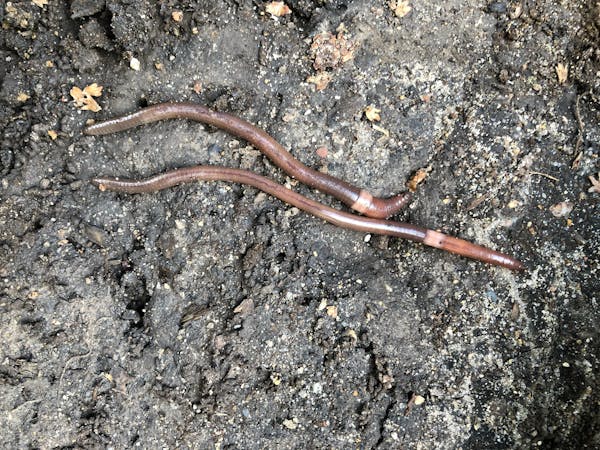Bait stores across Minnesota will soon need to make sure they're not selling anglers a writhing, twisting invasive species that looks an awful lot like an ordinary nightcrawler.
Starting July 1, the Minnesota Department of Natural Resources will prohibit selling or possessing jumping worms, which have been steadily spreading in the state since the early 2000s. The worms, native to Asia, have primarily been found in Minnesota around the Twin Cities, where they've upended gardens and infested old forests and major parks.
Jumping worms are particularly damaging to woodlands because they can destroy the first layer of topsoil, breaking apart the roots and connections that hold it together. The loose dirt, which looks and feels like used coffee grounds, washes away in the rain, keeping native plants and seedlings from ever establishing roots, DNR experts and foresters at the University of Minnesota warn.
Infested forests become less bountiful, producing smaller, more sickly trees and plants. When plants go, the insects and animals that rely on them follow.
DNR enforcement officers don't know of any bait shops in Minnesota that are purposefully selling jumping worms, said Laura Van Riper, the terrestrial invasive species program coordinator for the DNR.
The move to ban sales of the worms is proactive, she said. And it will help make sure that ordinary bait is not contaminated.
Experts believe the worms have been mainly spreading through potted soil and bags of mulch, as new infestations have usually been found near private lawns and gardens.
Identifying jumping worms
Jumping worms are a type of earthworm. They look very similar to other worms, but they have a distinctive light-colored band near their head. They're mainly identified by the way they move — they wiggle much more than a typical worm, especially when disturbed, appearing to jump out of the ground.
There is no good way to get rid of them. The U is researching ways to chemically control them in gardens, but those chemicals would never be a practical way to kill worms in a forest.
All worms in Minnesota are invasive. The glaciers of the last ice age would have killed off any that may have once lived here. The forests that grew up over the last 11,000 years evolved without them, making Minnesota particularly vulnerable to worm damage.
The ban on jumping worms should not noticeably impact anglers, the agency said.
DNR officials said enforcement officers don't plan to inspect the bait of anyone actively fishing. They won't check boats or piers to make sure worm tins are free of jumping worms.
Nightcrawlers and other bait worms can still be sold. The agency said it may inspect bait stores to make sure jumping worms haven't infested their supplies and will respond to any complaints.

Want to share info with the Star Tribune? How to do it securely

'Safe recovery sites' would offer syringes, naloxone and more to people using drugs. The plan could be in peril.
New Minnesota GOP leaders seek peace with party's anti-establishment wing

Who is Republican Lisa Demuth, Minnesota's first House speaker of color?

